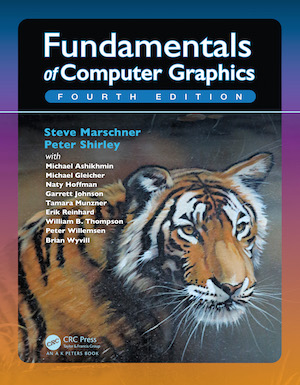CSC317H1F LEC 0101 2001 Monday 11:00-13:00, UC 140 Tutorial: Wednesday 11:00-12:00, UC 140
CSC317H1F LEC 0201 2101 Monday 15:00-17:00, AH 400 Tutorial: Wednesday 16:00-17:00, AH 400
Prof. Karan Singh karan@dgp.toronto.edu
Office hours: BA 5258, Mondays 13:00-15:00 or by appointment
This course introduces the basic concepts and algorithms of computer graphics. It covers the basic methods needed to model and render 3D objects, including much of the following: graphics displays, basic optics, affine and perspective transformations, windows and viewports, visibility, illumination and reflectance models, parametric representations, curves and surfaces, texture mapping, graphics hardware, ray tracing, graphics toolkits, animation systems.
Prerequisites: C/C++ Programming, Linear Algebra, Calculus,(course codes.
Please post your questions about the lectures, readings, and assignment due dates on the Quercus discussion board. We will monitor this board and attempt to answer questions as they appear. Near deadlines responses may take longer, so please start assignments early. If your question is not being answered, you may ask it again at the tutorial or office hours.
For questions specific to each assignment, please post your questions as a GitHub issue on the assignment repository.
This class involves required reading from:
Fundamentals of Computer Graphics, Fourth (or Fifth) Edition, Steve Marschner, Peter Shirley, et al. 2015.
Digital e-book are available at CRC Press.
| % | Item |
|---|---|
| 9% | Assignment 1 |
| 9% | Assignment 2 |
| 9% | Assignment 3 |
| 9% | Assignment 4 |
| 9% | Assignment 5 |
| 9% | Assignment 6 |
| 9% | Assignment 7 |
| 9% | Assignment 8 |
| 12% | 4 Quercus quizzes |
| 16% | Take home term test |
| Week | Topic / Event | Slides | Videos |
|---|---|---|---|
| 1 (12/09) |
|
introduction raster |
|
| 2 (19/09) |
|
raycast | raycast |
| 3 (26/09) |
|
raytrace | raytrace |
| 4 (03/10) |
|
bounding-volume | |
| 5 (17/10) |
|
meshes | |
| 6 (24/10) |
|
transforms and shading slides | |
| 7 (31/10) | TBD | ||
| 8 (14/11) | TBD | ||
| 9 (21/11) |
|
kinematics | |
| 10 (28/11) |
|
mass-spring | |
| 11 (5/12) |
|
||
| 12 (8/12) |
|
Academic Honesty (required reading)
Assignments must be submitted electronically, using MarkUs.
Code that you submit to us must work on the CS Teaching Lab machines in order to earn credit.
0.007% off for every minute late.
All assignments must be completed individually.
Any code must belong to the student submitting it. Submitted assignments will be automatically analyzed to identify suspicious levels of code similarity. Consequences of committing an academic offence can be severe.
By enrolling in this course, students acknowledge that they have read and understand the University of Toronto's definitions and policy on Academic Integrity.


